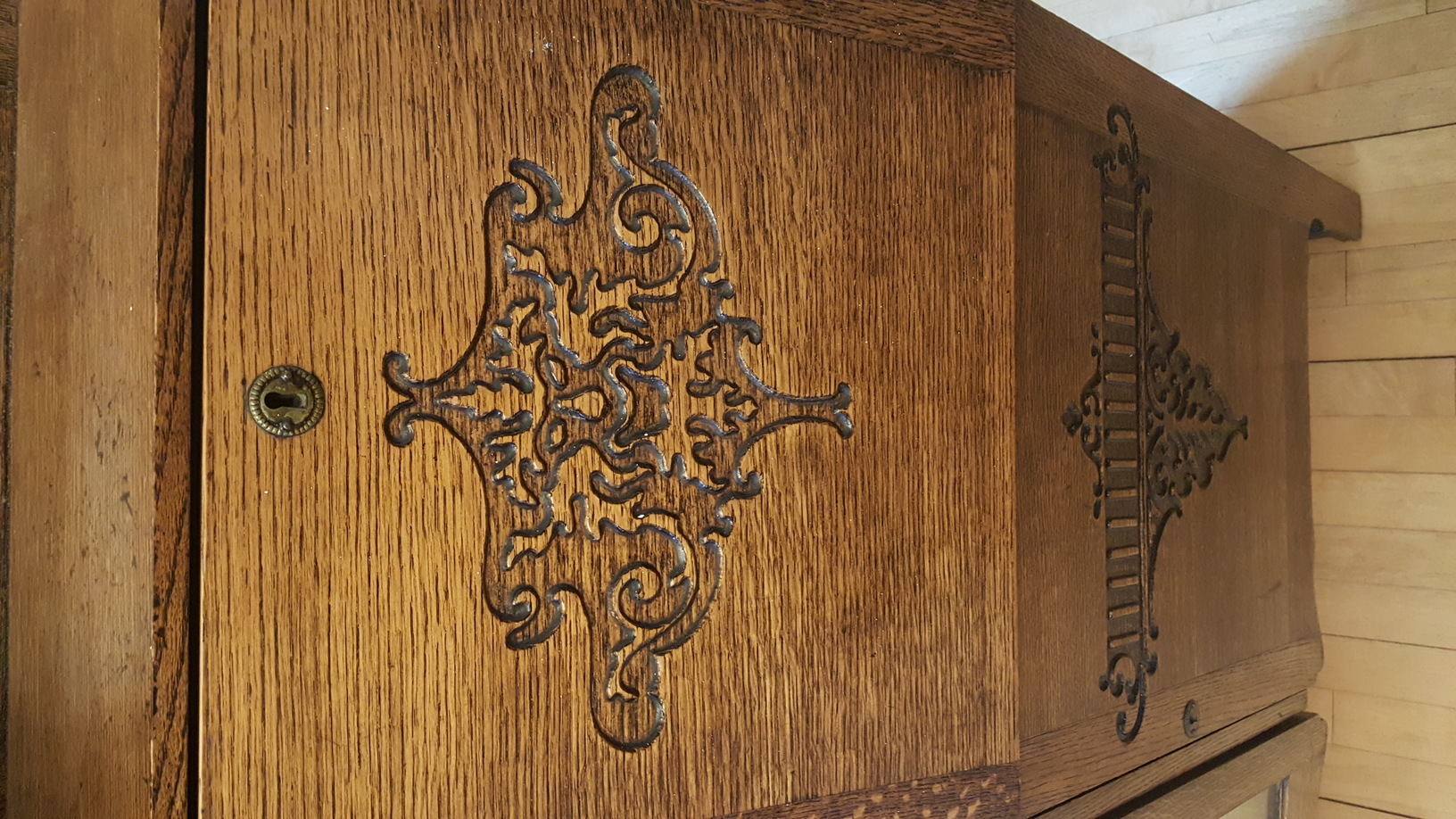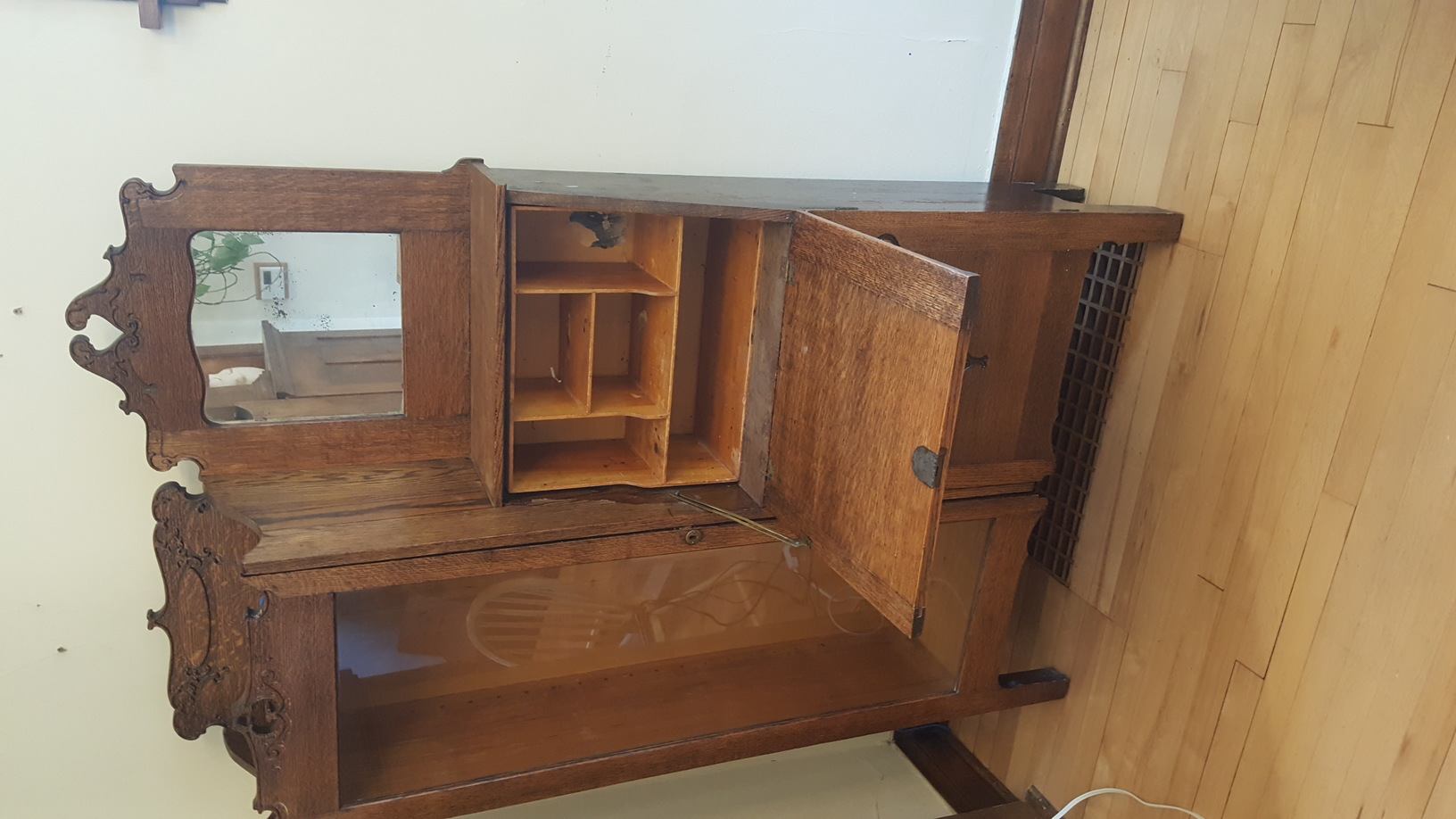Posts: 706
Threads: 0
Joined: Dec 2011
This hutch sat in my grandparents' house for as long as I can remember and it since followed my grandma to an apartment and now the nursing home. Since there wasn't enough room in the nursing home, it was natural the only furniture maker in the family got it. It comes with almost no details of its origin beyond an approximate date of before 1930. It was given to my grandparents from my Grandpa's parents and all I have is the earliest date anyone remembers it around.
I wouldn't go so far as to say that it's "fine furniture" because it seems to be mostly butt joints and nails as opposed to joinery. It is made of oak. With the amount of ray-fleck, I'm leaning towards White oak but it could be red. I looked for the porus endgrain but can't tell either way. The back panels seem to be machine finished as I couldn't find any tool marks, but they are solid wood and not ply. The glass is almost certainly replaced because I'd expect a piece this old to have rolled glass but the pane in there is pretty clear and flat. The mirror seems to be really old and possibly original. I figure the carving is probably the best bet in getting any sort of information on it. Any ideas??
Posts: 527
Threads: 0
Joined: Feb 2021
Location: Stevi, Montana
For me the story and history of the piece is the most important
Posts: 706
Threads: 0
Joined: Dec 2011
You're very right. Even if I don't learn anything about the hutch, myself and my children will continue to enjoy it in our homes for a couple more generations at least. I'm hoping that a little more information might help me piece together a little family history as well.
Posts: 3,657
Threads: 0
Joined: Jan 2005
If I had to guess based on a picture only, I'd guess it was made in the 1880 - 1920 time frame. Take a look at the nails, screws, what the back is made out of and the wheels (which appear to have been removed) as they may help date it better. Another dating item is the carved details and whether it's actually carved or applied to the cabinet.
I'm thinking it's closer to 1920 just because of the flat glass on the door and what carving I see appear to be machine made.
The wood appears to be white oak, things like the key cover and lock appear to be from that period. Don't know about the hinges or the writing surface hardware as I can't see them well enough. Joints appear to be tongue and groove.
It looks like a good piece, it may not be 'valuable' as some pieces are but it's still a desirable piece none the less. Make some new shelves with proper profile on the front, fill it with display items and enjoy it.
Posts: 706
Threads: 0
Joined: Dec 2011
04-19-2021, 06:10 PM
(This post was last modified: 04-19-2021, 06:23 PM by mr_skittle.)
It seems to me a piece of furniture for folks of modest means that serves the purpose of 3 or 4 different pieces. In a wealthy house there would be a separate piece for a display cabinet. God knows a secretary is a stand-alone piece. Then there is the mirror which might serve instead of a dressing table, for the lady of the house. There is also the cabinet underneath which could either be part of the secretary or a tiny sideboard for the dining room.
The carving is all relief. How would I tell if it is machine done? And beyond that, how was carving being done by machine early in the 20th century? Another interesting detail is that the outside rails of the display case door and the storage door go all the way to the ground. There is something stamped on the back but I can't make it out entirely.
I'm not 100% sure of the secondary woods. I think it could be butternut. It's pretty soft and I know it's not pine. The shelves match the back panels so I'm guessing they are original. Based on the patina of the back, I'm guessing it's original. The nails all seem modern, round with a thin, flat head. The screws are plain, flathead wood screws. The locks seem to be original. The hinges are writing desk hardware are pretty standard. Like anything you'd get off the shelf today.
Posts: 9,914
Threads: 1
Joined: Apr 2005
Location: Texas
Our family has one very similar or possibly almost identical, but I don't have a pic because my sister has it.
I was told it was "manufactured" furniture from the 1930's that was mass produced.
Ours is oak, as most of that type of furniture was at the time.
It was not high end at the time, because my mom's family, where it came from, was poor.
...Naval Aviators, that had balz made of brass and the size of bowling balls, getting shot off the deck at night, in heavy seas, hoping that when they leave the deck that the ship is pointed towards the sky and not the water.
AD1 T. O. Cronkhite
Posts: 23,784
Threads: 0
Joined: Jan 2004
I've never understood the hate on butt joints. My kitchen drawers are all butt joints and have been in daily use since 1946. Its not high end, but it obviously works.
Your piece has been in service even longer. That indicates it was an appropriate joint for the task.
Matt
If trees could scream, would we be so cavalier about cutting them down? We might, if they screamed all the time, for no good reason.
-Jack Handy
Posts: 2,267
Threads: 90
Joined: Jun 2001
It's called a secretary. Very popular in the 20-30's. Most were white oak and factory built. That one looks like it was taken care of.
John
Always use the right tool for the job.
We need to clean house.
Posts: 706
Threads: 0
Joined: Dec 2011
Don't take my comments as "hating on butt joints". As I'm sure anyone here knows, joinery work can tell you an amazing amount about a piece of furniture. In this instance, they gave me the clue that the piece was probably wasn't made to order in a custom shop. They are clearly a respectable joint as this piece of furniture is still holding together well.
All the information folks have provided matches my understanding of the history of the piece. The timeframe of the 20's-30's, relatively inexpensive and manufactured, and it is white oak. This doesn't give me much insight into my Great-Grandparents that I didn't already know but that's fine. It's really about my curiosity. While I do have some heirloom jewelry and tools that predate the piece, this will be the oldest piece of furniture in our house and I'm thrilled to give this modest piece another 100 years of life. I am going to make some WO shelves for it though, to match the rest of the case.
I am still really curious about how factories were doing this sort of carving 100 years ago. Was the predecessor of the router or CNC in service then?
Does anyone have input about the secondary wood possibly being butternut or where it might have been manufactured. My old man LOVES to find original sales ad's and stuff like that and if we can get a clue, he'd be all over it.
Posts: 1,396
Threads: 2
Joined: Jun 2003
04-22-2021, 02:18 PM
(This post was last modified: 04-22-2021, 02:21 PM by rwe2156.)
It could an individual maker, without a signature stamp you'll never know. The carving is definitely by hand. If manufactured, maybe outsourced. But the carving points me to and individual maker, not a manufactured piece.
It its put together with dowels, that points to mass-manufacturing.












